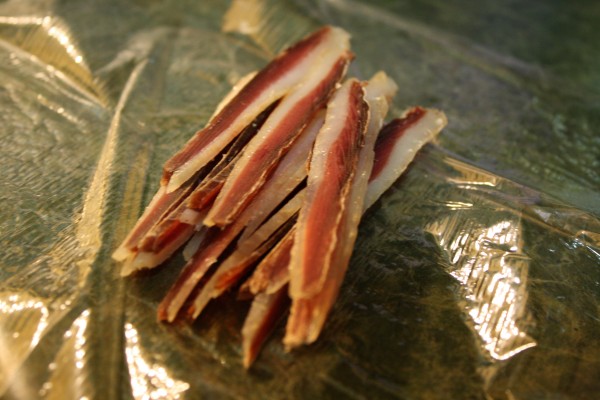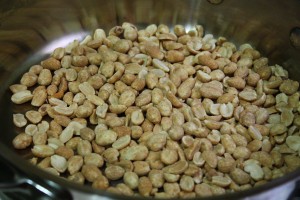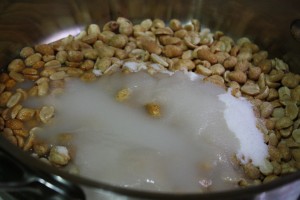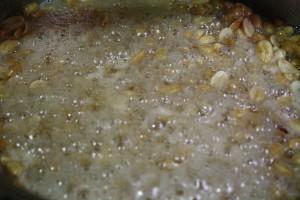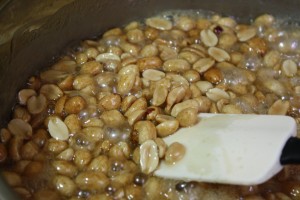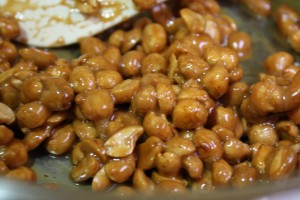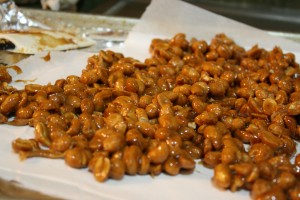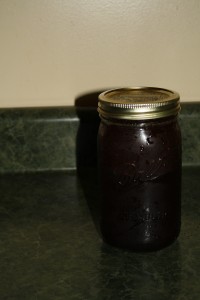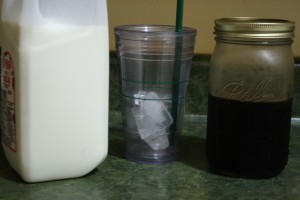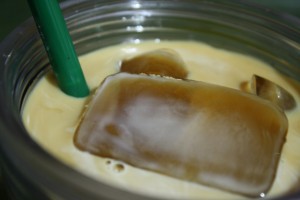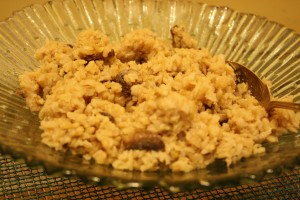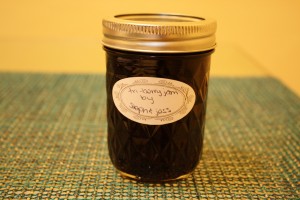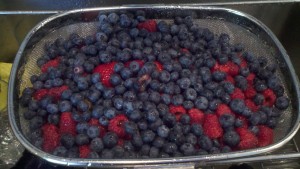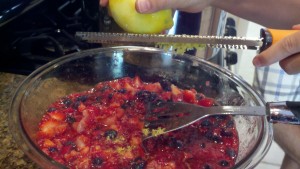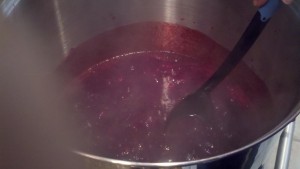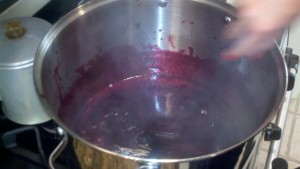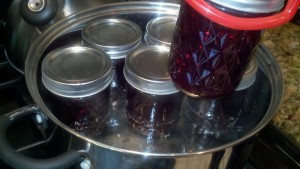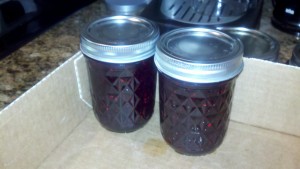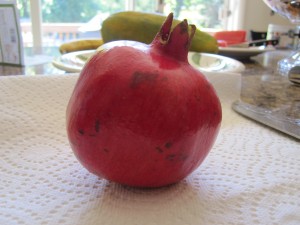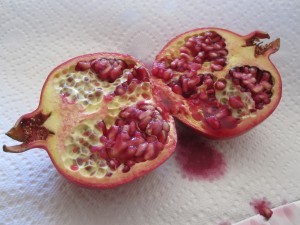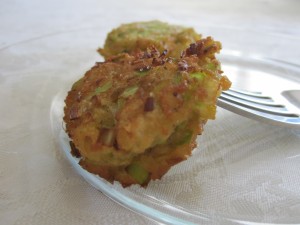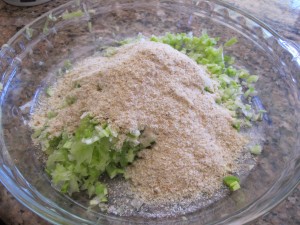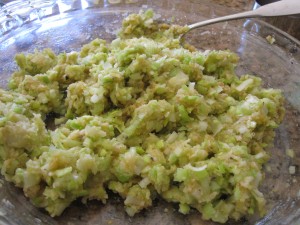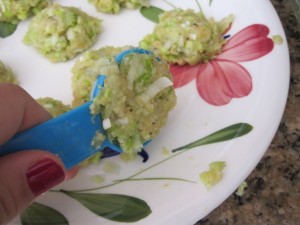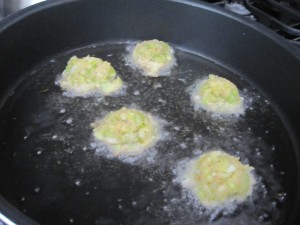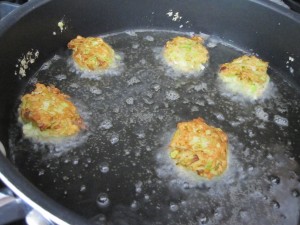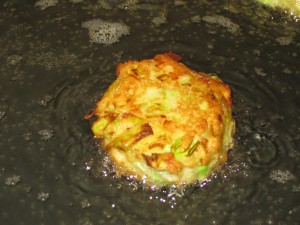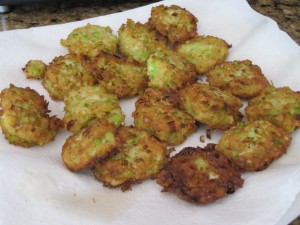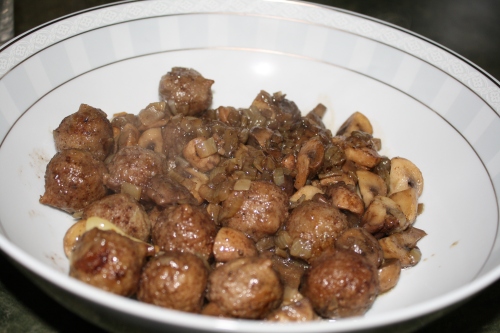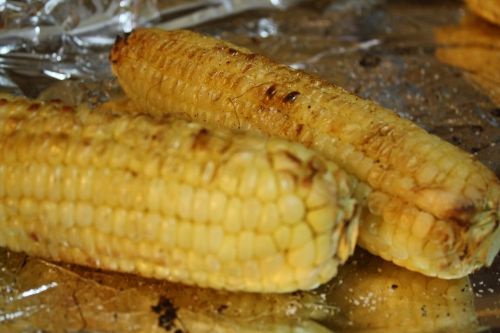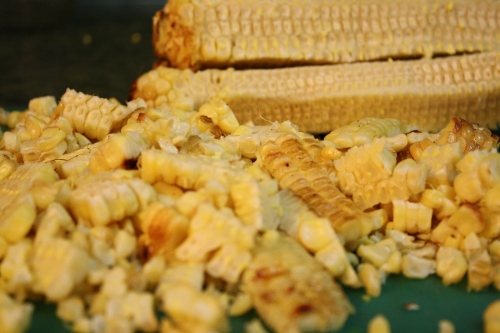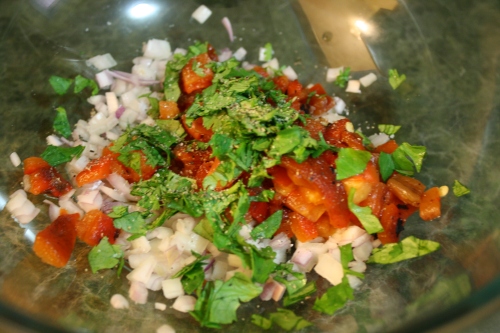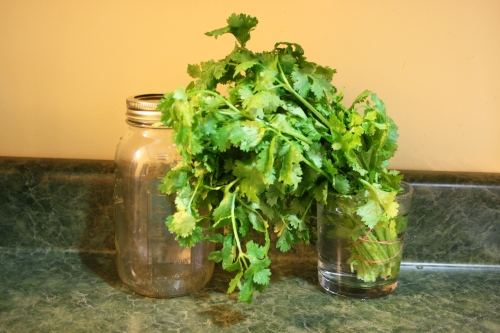What, just because we keep kosher doesn’t mean we can’t experiment with charcuterie! Continue reading
Author Archives: Jessica
Candied Peanuts

Mmm, peanuts. Mmm, caramel. Well here we have the best of both worlds in what has to be the easiest candy I have ever made! It gives the flavor of peanut brittle (I’ll share that recipe with you soon, I promise) but can be thrown together without a thermometer and pretty much three ingredients. Make this the next time your friends come over, you won’t be sorry. It would also be a great hostess gift. My friends and family like it when I bring baked goods, but when I bring candy, they go crazy.
I have a confession to make. These peanuts are not supposed to be clumped together. Each individual peanut was supposed to be covered in hardened caramel. I was devastated when I took these off the fire, perhaps a few seconds too late. Then I tasted them, and that feeling went away fast. They’re awesome! So don’t worry if you make a mistake. You’ll probably like these anyway (what’s not to like?).
Never made candy before? Don’t fuss! This is the perfect place to start. You’re still boiling and bubbling sugar (see above), you’re still adding the nutty peanut, you’re just not messing with fussy crystallizing sugars and candy thermometers. Not that we don’t love those, but they’re not great for first timers. The only thing you need to be careful of with this recipe is stirring. Keep on stirring. Don’t stop. I know this is easy: three(ish) ingredients and one pan, but that caramel can burn if it’s not moved around enough. Have you ever tried cleaning burning caramel off the sides of a pot? I have; it’s not so fun, trust me. Pay attention and you’re pretty much guaranteed to get this right the first time.
If you’re confused by the instructions, don’t fear! That’s why we have everything broken up into short steps. That’s why we have pictures of each step. It’s easy, I promise! Now try it. You definitely won’t regret it. The people you share it with will love you forever.
Candied peanuts, adapted from David Lebovitz
Ingredients:
- 2 cups peanuts
- 1 cup white sugar
- 1/3 cup water
- A pinch of cayenne pepper (optional)
- Kosher or sea salt (amount depends on the saltiness of your peanuts)
Directions:
1. In a large tall-sided saute pan, add peanuts, sugar, and water.
2. Turn heat to medium and stir the peanuts with the sugar and water. The sugar should dissolve into the water. The water will start bubbling. Continue stirring.
3. Keep stirring. The water should evaporate slowly.
4. Keep stirring. When there’s no more water, you will notice that it looks kind of sandy and is getting harder to stir. The caramel is light in color. Lower the heat slightly and stir until it is dark.
5. Keep stirring, scraping caramel from the bottom and coating each and every peanut in it. Tilt the pan away from the fire as you stir to regulate the heat.
6. Sprinkle with cayenne and salt.
7. Using a spatula, scrape the peanuts onto a silicone covered baking sheet. Flatten as much as possible and let cool. [See picture below. I didn’t do a great part flattening this. Next time I’ll use a baking sheet to flatten from the top – the peanuts are very hard to break these apart if they’re not in a single layer.]
7. When cool, break apart peanuts (I used my hands, but you can use a mallet if you want smaller pieces)
Cold Brewed Coffee
Everyone in the Deal area is going crazy over Rook Coffee Roasters. Yes, we agree, it’s delicious! And adorable and cute and teeny. You know why their iced coffee is so delicious? Because they cold brew it. And they use organic milk. Okay, it helps that they have good quality coffee and everything, but cold brewing is a big deal. They just rock is all.
We’ve been cold brewing our coffee ever since 2007 when the New York Times posted an article about it. We were hooked, and never went back to chilling hot coffee again!
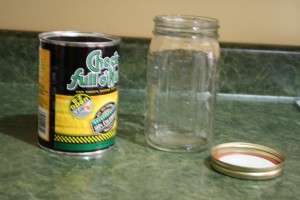 Okay, so I didn’t use the greatest quality coffee this time, but one of the greatest things about cold brewing is the fact that it’s awesome anyway! and Chock full o’ Nuts was on sale last week, so I had to buy it.
Okay, so I didn’t use the greatest quality coffee this time, but one of the greatest things about cold brewing is the fact that it’s awesome anyway! and Chock full o’ Nuts was on sale last week, so I had to buy it.
Cold brewed coffee is super strong, so either dilute it with some water or have it “latte style” with half coffee and half milk. I like my coffee creamy, so I opt for the latter, but it’s also quite amazing with water (1:1 coffee to water ratio) and a splash of cream or milk. If you’re a fan of the smokey flavor, add some hickory chips in the cold brew and sweeten it – that’s a New Orleans style brew for you.
As long as you have a Ball jar (where can we get those GIANT ones, please?), some coffee, and filtered water, you can make great coffee at home. No fancy machines needed. You don’t even need measuring cups, because the measurements are marked on the jars.
After straining, it keeps in the fridge for a couple of months! So now you can enjoy a refreshing cup of iced coffee every Shabbat and during all of these holidays we’re in the midst of!
I know you’ll miss the beach, camp, and summer in general. But amazing iced coffee is one thing you don’t have to miss all winter long.
Cold Brewed Coffee from The New York Times:
Ingredients:
- 1/3 cup of coffee to every 1 cup water
- Filtered water (I use water from my Brita)
- A tiny pinch of salt (optional) – I like listening to Alton about everything. He puts salt in his coffee before brewing to get the harshness out of it. Without brewing, there really is no harshness, but salt brings out flavors, and we LOVE coffee, so we put a teeny pinch of salt.
Instructions:
1. Add coffee to jar (I use a 3-cup mason jar, so I put one cup of coffee)
2. Fill Jar with water (3 cups)
3. Let sit on counter for 12-24 hours.
4. Strain coffee grinds – I just pour it straight through the coffee filter in my coffee maker. Sometimes I put some cheese cloth or a coffee filter over another mason jar and pour it through, but that involves me standing over it for a while. This is WAY easier.
5. Enjoy the iced coffee any way you like it! My favorite is some crushed ice, half whole milk, and half coffee. What’s your favorite way to drink coffee?
Like the “green” coffee cup? It’s from Starbucks. A grande reusable double walled plastic cup. It rocks. If you see it there, buy 20, because they sell out fast. We also have a “venti” one with a candy-cane striped straw! Oh, and Starbucks gives you a discount if you use it. Other places aren’t so interested in filling it for you, but they’re perfect for bringing coffee from home!
Meatless Mondays: Mushroom Rice
A version of this dish is a staple in my mother-in-law’s kitchen. When we go there for barbecue on Sunday nights, we always have this delicious mushroom-y rice that she made using leftover Shabbat rice (Syrians make a lot of rice). I decided to duplicate this dish in a non-leftovers way and used brown rice to make it a little healthier. You can try it with your favorite kind of rice. Continue reading
Triple Berry Jam
Summer’s coming to an end, so stock up on your berries and preserve them any way you could. Our favorite way to do this is to make jam. Though freezing is probably easier, cooking and preserving the berries is a very flavorful way to enjoy our summer produce all year long. It also makes a really nice gift!
(Berries actually freeze quite well. Make sure to clean and dry them, and then store them in a zip top bag. Make sure to suck all the air out and seal it tight so that the berries don’t get freezer burned. If you want to freeze strawberries, hull them before freezing.)
Last year we made raspberry jam with raspberries we picked ourselves from a local farm. We also made strawberry-fig jam, inspired by my backyard fig tree. This summer we decided to make more mixed fruit jams, and the apricot-nectarine turned out really orange and delicious. This raspberry-strawberry-blueberry jam is an amazing deep purplish pink color. We can’t decide if it tastes better than it looks or looks better than it tastes.
Oh, we took all the photos with my new(ish) Droid-X. Pretty cool, huh?
All jam making directions and tips are from pickyourown.org and the package of pectin.
Ingredients:
- 10 cups of unprepared berries, we used 2 pints of blueberries, 1 1/2 pints of strawberries, and 3 (1-cup) packages of raspberries (when you mash these, you’ll have about 6 cups of fruit)
- Juice and zest of two lemons
- 6 cups white sugar
- 1 package Sure Jell pectin (the yellow package)
Equipment:
- 1 large pot
- 2 large bowls (one for berries, one for sugar)
- Measuring cups
- 1 large pot
- Potato masher
- Mixing spoon
- Cup of ice water and teaspoon (to test jam)
For canning:
- Mason jars with tops and rings
- Canning funnel
- Magnetic lid lifter
- Jar tongs
- Small pot for boiling the lids
- Pot for boiling prepared jars
- Dishwasher or large pot for sterilizing jars
Instructions:
If you are canning, make sure to sterilize the jars. If using a dishwasher, run it without soap. If using a pot, fill the pot with water and the jars and boil. Do not touch the inside of the jars (that’s why you have the jar tongs), because that will introduce bacteria to the sterilized jars and could result in icky jam! Do this now so it will be ready when you are. Boil the lids, too.
1. Wash the fruit. Sort through it to make sure you have no bad berries or stems, etc.
2. Chop the strawberries.
3. Add the fruit to a bowl and make sure you have 10 cups. Mash.
4. Measure out the sugar. Set aside 1/4 cup of sugar and mix with the pectin. This will allow the pectin to incorporate into the fruit better, and make sure you don’t have lumpy jam.
5. Add fruit to large pot and cook over high heat, stirring constantly. When it comes to a full rolling boiling, meaning it doesn’t stop bubbling even when you stir, time one minute. Add the pectin and stir until it dissolves.
6. While still stirring, add the sugar, a cupful at a time, until it is all incorporated.
7. Continue stirring constantly until the mixture comes to a rolling boil again. After one minute, test the jam to make sure it sets.
8. Take a spoonful of jam and dip it in a cup of ice water. If it gels, it’s ready to be jarred. If not, boil for another minute and test again.
9. Use a ladle or big spoon to fill the sterilized jars. Leave about 1/2 inch of space at the top.
10. Use the magnetic lid lifter to cover, making sure to clean the jars before placing the tops on. Screw on the lid.
11. After all the jam is canned, place in about 2 inches of water and boil for 5 minutes (or more, depending on altitude). You will hear the tops POP, either while they are boiling or after when they are cooling. If you don’t hear the pop after a while, try boiling again or just put the jam in the fridge and use it right away. It will still be good.
12. The boiled jars should last about a year (’til next summer).
This recipe made 10 6-oz jars of jam.
Leek Ejjeh + Happy New Year
Chag Sameach everyone! We hope everyone has a sweet and healthy new year.
Everyone knows the custom of dipping apples in honey for Rosh HaShanah…actually, our family has different customs (and we don’t even have honey at the table, we use sugar instead). The Sephardic custom is to make many brachot on simanim, the symbolic foods we eat during the seder, before the meal. Before sharing the Leek Ejjeh recipe with you, I thought I might explain what our holiday meal with consist of tonight, and share the simanim that we will eat in order to celebrate the new year. Some more information on a (somewhat different) Rosh HaShanah seder can be found here.
The first siman is apples dipped in sugar (or honey). We eat this so that we will have a good and sweet new year. Cut the apples and serve with a bowl of sugar. Done.
The mext is tamarim, or dates. We eat this so that our enemies may be destroyed. No need to prepare these, we just buy dried dates – medjool dates are quite tasty on their own.
The third siman is leeks. We eat these so that our enemies will be destroyed (again). The recipe for leeks is at the bottom of this post – thanks for your patience!
The fourth siman, swiss chard, is eaten in hopes of removing our enemies (yet again).
The fifth siman is gourd. We make a bracha asking God to tear up any oppressive decrees in areas where Jews live and to proclaim our merits before Him.
The next siman is black eyed peas, or Lubiyeh. We eat this in order to increase our merits. These small beans are eaten stewed with meat – our family uses kibbe (the same little meatballs I made with mushrooms the other day) – and served as part of the regular meal and the seder during the holiday meal.
We eat the next siman, pomegranates (or rimon), asking God to grant us bountiful merits and goodwill, as many as the fruit’s seeds. Cut the fruit in half and immerse in a bowl of water while scraping the seeds away from the flesh with your fingers. The white flesh will float to the top, and the seeds will sink to the bottom. Scrape the flesh from top of the bowl and drain the seeds, it’s as easy as that. This method also stops your kitchen and clothing from getting all red.
Lastly, we eat tongue as the next siman. Tongue is eaten to symbolize a lamb’s head (I think some families eat fish, as well). This is to symbolize that we will be leaders (at the head) rather than followers at the trail. The meat is also a reminder of the ram that Avraham sacrificed instead of his son, Yitzchak. We buy tongue from the deli. Most people at the table don’t want to eat it.
The last thing we eat, after the simanim, is a new fruit. This should be a fruit that has just come into season, and therefore we were unable to eat for an entire year. We say Shehechianu on this fruit and thank God for keeping us alive and bringing us to this season. Our family usually eats starfruit or dragon fruit.
And without further ado, the leek ejjeh we will be enjoying for the next two nights:
We actually make our leeks into small latkes, quite similar to the tasty Chanukah treat. They’re delicious this way – crispy, tasty, and small. Not breaded like onion rings, but with the same flavor. They taste somewhat similar, actually.
Ingredients:
- 2-3 large leeks, or 4-5 small leeks, washed well and chopped (don’t try to grate them on a box grater. They will get stringy)
- 1/2 cup breadcrumbs or matzah meal
- 2 eggs
- Egg white from one egg
- Salt and pepper
- Vegetable oil, for frying
Directions:
1. Prepare oil for frying: pour about 1/2 inch of oil into a high-walled pan. Place on burner over medium heat.
2. Combine leeks, eggs, and breadcrumbs. Mix to combine. Check consistency. If it’s too dry, add the egg white. If too wet, add more bread crumbs. The batter should be loose but be able to come together into a ball if squeezed. Add salt and pepper.
3. Using a tablespoon measure, scoop out batter into balls.
4. Test the frying oil with a tiny amount of batter. Make sure it sizzles but doesn’t burn. Prepare a plate or tray to drain the patties after frying. I used a paper towel-lined plate. My grandmother used to use brown paper bags (yes, the ones from the grocery store). Alton brown uses a cooling rack on top of a towel-lined cookie sheet. That’s probably the best idea if you can do it.
5. Using a slotted spoon, drop the batter, one at a time, into the oil, flattening into patties as you drop them. Only put 5-4 in the oil at a time, because you don’t want the temperature to drop too much and the patties to get soggy.
6. After one minute, they should be brown. Flip the patties. Fry on the other side for a minute. Remove from oil with slotted spoon and place on draining plate. Repeat until all are fried.
7. Sprinkle with salt when still warm.
8. Serve along with the bracha: “that those who hate us be cut away”
Shana tova!
Kibbe Mushroom
Kibbes are our version of little meatballs, and are a staple in the Syrian household. We cook them with peas, cherries, sour soup and many other savory dishes. Let’s just say it’s not Friday night without a kibbe (or many) at the table. Now don’t confuse these little kibbe meatballs with the bulgur-shelled and meat-stuffed kibbe torpedoes. They’re completely different. If that made no sense to you, continue reading this blog, we’ll definitely explain more about these middle-eastern staples soon! Continue reading
Cedar Plank Salmon
 Technically, grilling season is almost over. But I’m not ready to start cooking inside just yet…you’ve never been in my kitchen in the summer. It is just too hot! So I spent a lot of the summer in the yard cooking. I figured out that meat and chicken aren’t the only thing you can cook on the grill. I decided to change it up a little and make some salmon using cedar planks I picked up from Whole Foods. I’ve never actually eaten plank salmon, and I don’t really like strong smokey flavors…talk about an impulse buy. But since I bought the planks, I had to try it. Turns out, the salmon was great! It wasn’t too smokey, but definitely tasted different and stronger than if it was just cooked in the oven. There was no fishy flavor, and the simple topping imparted the perfect amount of spicy sweetness. I’m definitely going to be using these planks a lot this grilling season. Continue reading
Technically, grilling season is almost over. But I’m not ready to start cooking inside just yet…you’ve never been in my kitchen in the summer. It is just too hot! So I spent a lot of the summer in the yard cooking. I figured out that meat and chicken aren’t the only thing you can cook on the grill. I decided to change it up a little and make some salmon using cedar planks I picked up from Whole Foods. I’ve never actually eaten plank salmon, and I don’t really like strong smokey flavors…talk about an impulse buy. But since I bought the planks, I had to try it. Turns out, the salmon was great! It wasn’t too smokey, but definitely tasted different and stronger than if it was just cooked in the oven. There was no fishy flavor, and the simple topping imparted the perfect amount of spicy sweetness. I’m definitely going to be using these planks a lot this grilling season. Continue reading
Engagement Cake
I mean, chocolate cake with marshmallow frosting!
Happy wedding day Helen and Joe!
This is the cake we made for their engagement party, our first ever attempt at a tiered cake. Helen requested chocolate, so when we found a recipe for deeply chocolate cake with marshmallow frosting, we knew we had to try it. Of course, since it was such a special occasion, a simple layered cake was not enough. We decided to make it tiered, with a flowery cake topper and everything. Continue reading
Meatless Monday: Roasted Corn Salad
Summer corn is here! That means that we eat lots of corn and get it stuck in our teeth. Yuck! This corn salad is a better way to eat that same corn without getting anything stuck in your teeth!
This recipe has quite a few steps, but ones that you can skip and have the store do for you, like roasting peppers and shucking corn. I did it all myself, but no one will know if you buy roasted peppers and use canned or frozen corn that you just roast in the oven for a while. Actually, what a great way to make this recipe in the winter when fresh corn isn’t available. As long as you don’t skimp on the fresh cilantro, I won’t tell anyone.
The flavors just get better when this sits, so make this ahead of time. Having company? Make it the day before and let it sit in the fridge. It’ll make your life much easier and it will make the salad taste better. I was going to add some black beans to this, but didn’t have any in the pantry. Turns out, I think it was perfect this way, but add the beans if you want to (a great Meatless Monday way to get some protein). Then let me know how it is. Maybe I’ll add those next time.
Ingredients:
- 3 ears white corn
- 1 red pepper
- 1 shallot, chopped
- Salt and pepper
- Chili powder
- About 1 tablespoon chopped cilantro.
Directions:
1. Season the corn with salt, pepper, and chili powder. Roast or grill the corn for about 15 minutes. Let cool.
2. Roast the red pepper over an open fire, rotating when the skin is black. When blackened, place in plastic bag and let steam for about ten minutes. Remove from bag, peel the black skin off, and cut into strips. Cut the strips into small pieces (about the same size as the shallots).
3. Combine the shallots, roasted peppers, salt, pepper, chili powder, and cilantro in a bowl.
4. Remove the corn kernels from the cob – using a sharp knife, hold the corn so that it is standing, and cut downwards. Don’t worry about all the kernels separating from each other, that’s part of the fun of homemade corn salad!
5. Add the corn to the bowl, and mix well. Add salt and pepper to taste. If you like cilantro as much as I do, add more!
See the bowl I used? It’s my favorite! I have it in three sizes. They make it in red, too, but I haven’t seen it since Adelaide’s closed.

